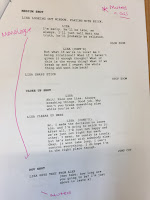Post 3
Introduction to Film
3 Act Structure
 1) The first act is usually used for exposure, to establish the main characters, their relationships and the environment (setting) they live in. Later in the first act, an on-screen incident occurs that confronts the main character (the protagonist), whose attempts to deal with this incident lead to a second and more dramatic situation, known as the first turning point, which :
1) The first act is usually used for exposure, to establish the main characters, their relationships and the environment (setting) they live in. Later in the first act, an on-screen incident occurs that confronts the main character (the protagonist), whose attempts to deal with this incident lead to a second and more dramatic situation, known as the first turning point, which :- (a) signals the end of the first act,
- (b) ensures life will never be the same again for the protagonist
- (c) raises a dramatic question that will be answered in the climax of the film.
The dramatic question should be framed in terms of the protagonist's call to action, This is known as the inciting incident, or catalyst. As an example, the inciting incident in the 2017 film, "The Greatest Showman," will Phineas T. Barnum overcome the protesting villagers and erect a show despite the riots?
2) The second act, also referred to as "rising action." This act typically depicts the protagonist's attempt to provide a suitable resolution the problem initiated by the first turning point, only to find themselves in ever worsening situations. The vast majority of the reason protagonists seem unable to resolve their problems is because they do not yet have the skills to deal with the situation that confronts them. To combat the confrontation, the protagonist must increase their sense of awareness of who they are and what they are capable of, in order to deal with their predicament, which in turn changes who they are. This is referred to as character development or a (more commonly known as a character arc.) This cannot be achieved alone and they are usually aided and abetted by mentors and co-protagonists. For example, in the 2009 film, "Avatar," Jake Sully uses the assistance of a Na'vi hybrid woman to defeat the military in their aim to effectively eradicate their species.
3) The third act features the resolution of the story and its subplots. The climax is the scene or sequence in which the main tensions of the story are brought to their most intense point and the dramatic question answered, leaving the protagonist and other characters with a new sense of who they really are. For example, in the 1997 film, "Titanic," Rose wins her final battle with Cal, but consequently loses her beloved Jack in the process.
Vladmir Propp

(1895-1970)
was a Soviet folklorist and scholar who analyzed the basic plot components of Russian folk tales. Propp did this in order to identify their simplest narrative elements. As a result of this, he soon identified a sequence of narrative elements (or 'functions') were typically custom with Russian fairytale. He identified 31 functions in Russian folklore and fairy tales. These functions occurred in a typical order within each story, with some minor variation. This type of structural analysis of folklore is the "syntagmatic" method. With respects to the analysis, some narrative elements of the plot may be taken out of their "given" chronological order within the story and regrouped in various analytic schemes. Similarly, equivalent to the terms listed above, are the terms "diachronic" and "synchronic". Diachronic entails the analysis that conveys a sense of traversing the highs and lows of a story, like riding the pattern of a radio-wave. The second term, synchronic, is where the story is instead absorbed as a whole, where each individual aspect is collaborated together to portray a story to the audience/reader (dependant on the media that is used to convey the narrative.) The vast majority of literature analyses are synchronic, portraying a much larger sense of organisation among the components of a story. Although, both structural analyses convey partial information about the story, each angle of analysis delivers a different set of information.
Genre
The term 'genre' relates to a style or category of art, music, or literature. More specific to film production, the sub-categories that a film can fall under is vastly based on the genre of the film. For example, the 2018 film, "The First Purge" is referred to as a horror, soley based on the content of the film. Alternatively, the 2004 film, "The Incredibles" is perceived as a "family" film. The "family" genre is a subjective genre as different perceptions of 'family friendly' depend on the individual.



Comments
Post a Comment